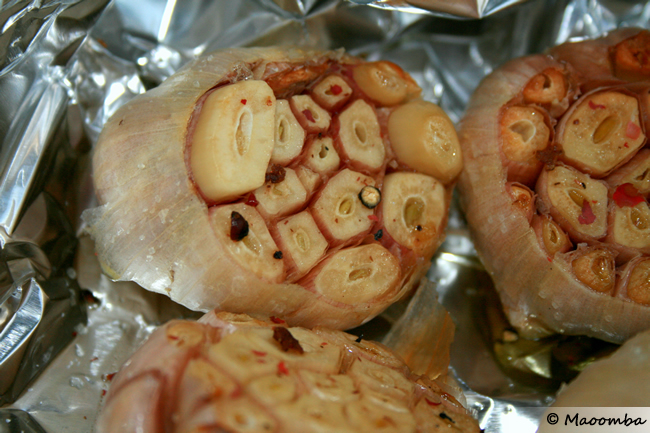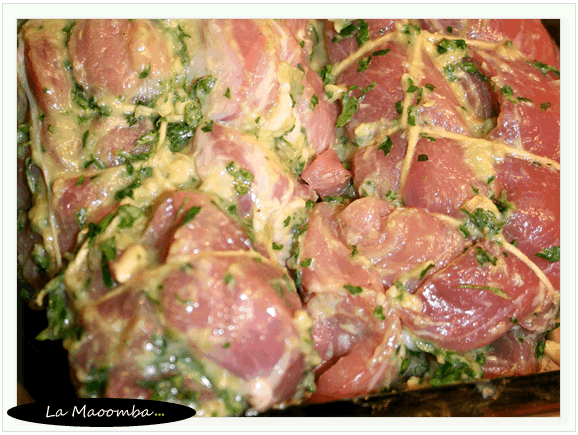Tomorrow is another Iron Chef night. The ingredient: garlic. I have no idea what the complete meal will entail, but, as it is our turn to host, we are preparing the entrée. With vegetarians and omnivores and food-sensitive folks in attendance, we opted for a garlic and parsley pork roulade with a balsamic glaze, and a roasted garlic and baby bella risotto – which I’ll get to in another post.

In all, I roasted 13 heads of garlic – 12 regular and 1 elephant. An older gentleman at the grocery store buying a single tomato seemed a bit shocked by my bag full of stinking roses.
I do have to admit that, as much as I love the smell of garlic, the roasting process was overwhelming. The smell was just too much and I had to head out for a run which, by the way, was amazing. Picture yourself running down a mountain road to a Bluegrass banjo-pickin’ pace, shadow-boxing with the setting sun against the freshly fallen snow. Fresh air, sunshine, deer on the mountain-side, and your heart pounding – wonderful.
Back to the garlic. I learned to tie a pork loin today. It was my first attempt ever. But, given that the pork loin was fairly narrow, I did not butterfly it in a way that lends itself to being rolled. Instead, it was folded. Oh well, the point is that it was chock full o’ the garlicky goodness that led my husband to invite our guests over for a little “drinky and stinky”.
Since dinner isn’t actually until tomorrow night, I’ve tied the roulade and am letting it sit in the refrigerator until tomorrow night. The plan is to baste it while it cooks with a balsamic roasted garlic glaze to add a little more moisture and flavor (though, I’m not really sure it will need it.) I’ll tackle the risotto tomorrow, as well.
The roulade recipe I used is largely based on one presented earlier this year by the Kitchenista, though, it includes quite a bit more garlic and a little extra wine. I figure you can’t go wrong with either.
Balsamic Garlic Glaze
- 10 cloves roasted garlic, mashed
- 1 cup balsamic vinegar
- 1 tsp raw honey
- 1 1/2 teaspoons sea salt
Directions
- Pour the balsamic vinegar, honey, salt and the mashed garlic into a pan and mix well.
- Simmer for about 10 minutes, or until the liquid reduces and becomes the consistency of syrup.
- You can make the glaze a day or two ahead of when you’ll use it.
Roasted Garlic and Parsley Pork Roulade
Ingredients and supplies:
- 2 lb boneless pork loin
- 2 Tbsp olive oil
- 2 Tbsp dry white wine
- 2 heads of garlic, roasted (or more)
- juice from 1 lemon
- 1 bunch of Italian (or flatleaf) parsley
- Salt and pepper to taste
- Kitchen twine / butcher’s string
- 1/4 c white wine, chicken broth or water
Roasting garlic
Top the garlic heads, i.e., chop off the top third or so. Put each head in a piece of foil, drizzle some olive oil, salt, and pepper on top, wrap, and bake for 50 mintues at 350 degrees. You can remove the paper from the leftover garlic tips and roast them in foil and oil as well. When done, remove garlic from oven, let it cool, and then squeeze out of the husks.
Paste
Place the roasted garlic cloves, white wine, parsley leaves, lemon juice, and salt and pepper to taste in to a blender or food processor. Chop to create a rough paste; do not puree.
Preparing the pork
1. Butterfly the pork loin. See Culinate.com‘s great photographic guide to doing this. See the image below for what it should look like.
2. Spread paste evenly across surface of the pork.
3. Carefully roll (that’s what roulade means) the pork from one long edge to the other.
4. Tie the roulade lengthwise using a 5-6 foot long piece of twine. See bon appétit for a visual and instructions on how to do this if you have not tied meat before.

Cooking the roulade
Pre-heat your oven to 350 degrees F.
Heat a casserole (or dutch oven) on the stove to medium-high heat. Pour in a little bit of olive oil and spread it around. Sear each side of the pork loin for 3 to 5 minutes, until browned. Pour the ¼ cup water, wine or broth into the bottom of the casserole, cover, and place in oven for 25-30 minutes.
Because many pork loins have limited fat, you will want to monitor it as it cooks to make sure that it is not too dry. You might consider basting it every ten minutes with the liquid at the bottom of the casserole or a glaze/marinade of your choice. Check the temperature after about 20 minutes; as soon as it reads 145 degrees F, pull it out of the oven and let it rest for 10 minutes to allow the temperature to reach 155 degrees F.
Cut string, slice, and serve with a drizzle of warm glaze.